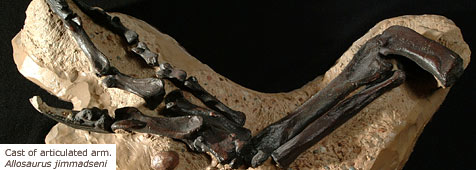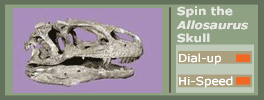



Some dinosaurs are harder to understand. No animal known today has two rows of bony plates along its back, as Stegosaurus did. Some people think that plates were protective armor, like turtle shell. Recently, scientists discovered many tiny channels in the plates that blood may have flowed through. This might have allowed sunshine to warm the Stegosaurus, and a breeze might have cooled them off. We may never know for sure, just as we may never know what colors dinosaurs were, how long they lived, or why they died out.
Scientists estimate that Stegosaurus measured 20 feet long and weighed 2-3 tons, while Apatosuarus measured 70 feet long, and weighed up to 34 tons.

The dinosaurs of Douglass Quarry lived in the middle of the Age of Dinosaurs, about 150 million years ago. The earliest dinosaurs that appeared during the Triassic Period about 220 million years ago, were small [9-12 feet] two-legged predators. They were one of nature's experiments that succeeded. The first dinosaurs survived, thrived, and ruled the earth for some 150 million years, while adapting to changing conditions. This is quite an accomplishment when compared to the mere 4 million years or so that humans have been on the earth!
The early dinosaurs multiplied. Some grew larger, some began to walk on four legs, and others grew into different shapes. Each new feature, a long neck or sharp teeth, or bony plates, if it helped the animal survive, was passed on to later generations. These features became the hallmark of each new kind of dinosaur. Certain groups, like the sauropods, thrived during the Jurassic Period [about 210 - 145 million years ago]. Later they became scarcer. Others like the ornithopods dominated the third and final period of the Mesozoic Era before all dinosaurs but for birds, became extinct 65 million years ago.










